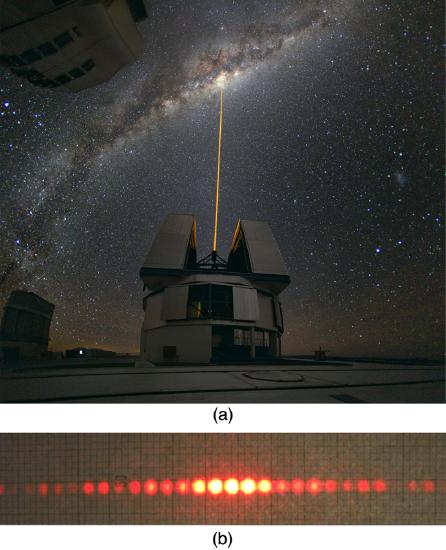27.1: The Wave Aspect of Light- Interference
- Page ID
- 2740
Learning Objectives
By the end of this section, you will be able to:
- Discuss the wave character of light.
- Identify the changes when light enters a medium.
We know that visible light is the type of electromagnetic wave to which our eyes respond. Like all other electromagnetic waves, it obeys the equation
\[c = f \lambda \label{27.2.1}\]
where \(c = 3 \times 10^{8} m/s\) is the speed of light in vacuum, \(f\) is the frequency of the electromagnetic waves, and \(\lambda\) is its wavelength. The range of visible wavelengths is approximately 380 to 760 nm. As is true for all waves, light travels in straight lines and acts like a ray when it interacts with objects several times as large as its wavelength. However, when it interacts with smaller objects, it displays its wave characteristics prominently. Interference is the hallmark of a wave, and in Figure 1 both the ray and wave characteristics of light can be seen. The laser beam emitted by the observatory epitomizes a ray, traveling in a straight line. However, passing a pure-wavelength beam through vertical slits with a size close to the wavelength of the beam reveals the wave character of light, as the beam spreads out horizontally into a pattern of bright and dark regions caused by systematic constructive and destructive interference. Rather than spreading out, a ray would continue traveling straight ahead after passing through slits.
MAKING CONNECTIONS: WAVES
The most certain indication of a wave is interference. This wave characteristic is most prominent when the wave interacts with an object that is not large compared with the wavelength. Interference is observed for water waves, sound waves, light waves, and (as we will see in "Special Relativity") for matter waves, such as electrons scattered from a crystal.

Light has wave characteristics in various media as well as in a vacuum. When light goes from a vacuum to some medium, like water, its speed and wavelength change, but its frequency \(f\) remains the same. (We can think of light as a forced oscillation that must have the frequency of the original source.) The speed of light in a medium is \(v = c/n\), where \(n\) is its index of refraction. If we divide both sides of equation \(c = f \lambda\) by \(n\), we get \(c/n = v = f \lambda / n\). This implies that \(v = f \lambda_{n}\), where \(\lambda_{n}\) is the wavelength in a medium and that
\[\lambda_{n} = \frac{\lambda}{n}, \label{27.2.2}\]
where \(\lambda\) is the wavelength in vacuum and is the medium’s index of refraction. Therefore, the wavelength of light is smaller in any medium than it is in vacuum. In water, for example, which has \(n = 1.333\), the range of visible wavelenghts is \(\left( 380 mm \right) / 1.33\) to \(\left( 760 nm \right) / 1.333\), or \(\lambda_{n} = 286 ~ to ~ 570 nm\). Although wavelengths change while traveling from one medium to another, colors do not, since colors are associated with frequency.
Summary
- Wave optics is the branch of optics that must be used when light interacts with small objects or whenever the wave characteristics of light are considered.
- Wave characteristics are those associated with interference and diffraction.
- Visible light is the type of electromagnetic wave to which our eyes respond and has a wavelength in the range of 380 to 760 nm.
- Like all EM waves, the following relationship is valid in vacuum: \(c = f \lambda\), where \(c = 3 \times 10^{8} m/s\) is the speed of light, \(f\) is the frequency of the electromagnetic wave, and \(\lambda\) is its wavelength in vacuum.
- The wavelength \(\lambda_{n}\) of light in a medium with index of refraction \(n\) is \(\lambda_{n} = \lambda / n\). Its frequency is the same as in vacuum.
Glossary
- wavelength in a medium
- \(\lambda_{n} = \lambda / n\), where \(\lambda\) is the wavelength in vacuum, and \(n\) is the index of refraction of the medium


